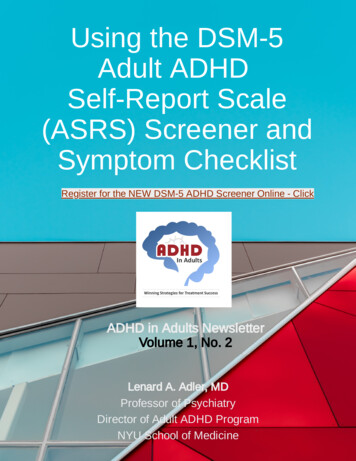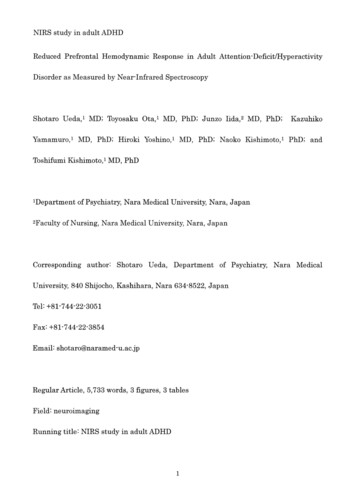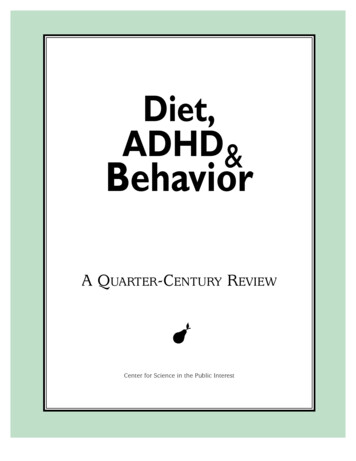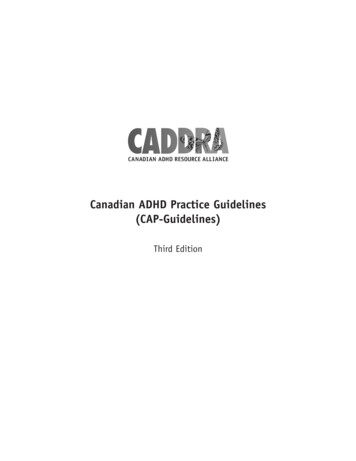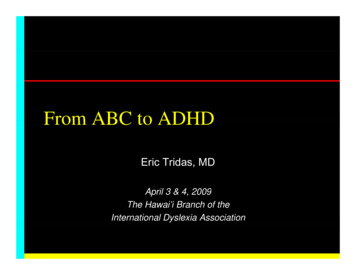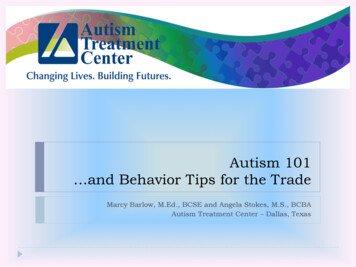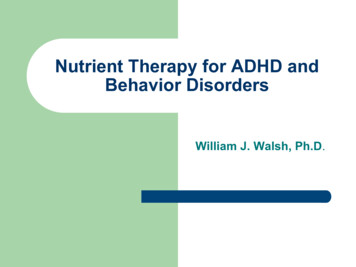
Transcription
Nutrient Therapy for ADHD andBehavior DisordersWilliam J. Walsh, Ph.D.
EARLY RESEARCH1.2.3.Prison volunteer work involving closecontact with ex-convicts & families.Many parents reported an abnormal infancyand troubled childhood: rages, violence,animal torture, fascination with weapons.Some parents of criminals seemed capable& caring, and had other children who werewell-adjusted, productive citizens.
Question: What is the Cause of aSevere Behavior Disorder?l l l l Tabula rasa (blank slate) theory: dominanceof life experiences,Adoption & twin studies (1970’s) indicategenetic predisposition for schizophrenia,bipolar disorder, clinical depression, autism,New research focus on neurotransmitters,receptors, drug medications,Argonne initiates studies of body chemistryfor convicted felons.
Metal-Metabolism Abnormalitiesl l l Study of death row residents & otherconvicted murderers indicates unusual levelsof Cu, Zn, Mn, Na, K, Li, Co.Similar chemical imbalances found in violentchildren.Formal experiments initiated at ArgonneNational Laboratory.
Sibling ExperimentTest Group24 violent malesAge range: 8-18 yearsMultiple violent incidentsControl Group24 brothers, living in same domicileAge range: 8-18 yearsNo violence or delinquency
Results of Sibling Experimentl Most controls exhibited expected levels ofmetals; Most violent subjects had abnormallevels of Cu, Zn, Mn, Pb, Cd, Na, K, Ca.l Two distinctive patterns of trace metals observedin violent subjects:-- Type A: Elevated Cu, Cd, PbDepressed Zn,Na, K, Li, Co-- Type B: Elevated Na, K, Cd, Pb, MnDepressed Cu, Zn, Li, Co
Family Survey of Violent SiblingsType A Subjects: Episodic violence, genuineremorse, high incidence of ADHD, LD, andacademic underachievement.Type B Subjects: Oppositional, defiant, cruel,assaultive, high pain threshold, fascinationwith fire, weapons.
Double-Blind Field Test (n 192)Test Group: 96 extremely violent prisonresidents, ex-convicts, and assaultivechildren.Controls: 96 non-violent males, matched forage and socioeconomic level in childhood.
Field Test Resultsl Results of sibling experiment confirmedl Type A & B patterns predominate in violentcohort; Most controls exhibit expected tracemetal levels.l P 0.001Conclusion:Most violent persons exhibit abnormal metal metabolism
Additional Trace Metal PatternsObserved in Delinquent ChildrenPattern C:Depressed Ca, Mg, Zn, Cu, Mn, Cr, Fe, Na, KHigh incidence of malabsorptionImpulsive, non-violent delinquency.Pattern D:Elevated Ca, Mg; Depressed Zn, Cu, Mn, Na, KSevere reaction to sugar, caffeineAcademic underachievementNon-violent delinquency.
Metabolic Studies by Carl PfeifferType A: Elevated Cu/Zn ratio in blood, high toxicmetals, histamine disorder, hypoglycemia, 30% havepyrrole disorder.Type B: Combination of high blood histamine, lowblood spermine, pyrrole disorder, hypoglycemia,elevated toxic metals.Type C: MalabsorptionType D: Hypoglycemia
Forensics Casesl l l l l l l James Oliver HubertyCharles MansonRichard SpeckPatrick RyanPatrick SherrillLudvig van BeethovenTwenty other notable cases
Examples of Forensics Findingsl l l l l l Charles Manson: Severe Type B chemistryJames Huberty: Cd poisoning; mild Type BRichard Speck: SevereType A chemistryPatrick Ryan: No abnormalities detectedPatrick Sherrill: Pb poisoning, Type ABeethoven: Severe Pb poisoning.
Clinical Populationsl 10,000l l l Behavior & ADHD4,600 Autism3,500 Schizophrenia & Bipolar3,200 Depression
Individualized Nutrient TherapyMedical History and Review of SymptomsExtensive Chemical TestingDiagnosis of Chemical ImbalancesPrescribed Nutrient ProgramNote: Best results for younger patients
Walsh Chemistry Databasel World’s largest chemistry database forbehavior disordered and delinquentpopulations.l More than 1.5 million chemical analyses ofblood, urine, and hair for 10,000 behaviordisordered persons.
Database FindingsMajor biochemical differences betweenPTC populations and the rest ofsociety.Several observed chemical imbalancesdirectly impact brain neurotransmitters.
High-Incidence Chemical Imbalancesin Behavior Disordersl l l l l l l Over-MethylationUnder-MethylationDisordered Metal MetabolismPyrrole DisordersToxicsEssential Fatty AcidsGlucose Dyscontrol
Frequently Asked Questions1.How can vitamins, minerals, or amino acidssignificantly help a violent or autistic child, adepressed adult, or a schizophrenic?2.Don’t you really need a powerful drug to getthe job done?
The Brain Chemical Factoryl Serotonin, dopamine, and other NT’s aresynthesized in the brain.l The raw materials for NT synthesis arenutrients: vitamins, minerals, and aminoacids.l Nutrient imbalances (genetic or acquired)can result in brain chemistry problems.
Nutrient Imbalances Impact NT’s- GABA synthesis requires Zn- Serotonin synthesis requires B-6- Norepinephrine is Cu dependent- DA, NE, 5-HT levels are impacted bymethyl/folate ratio.
Impact of Copper on Dopamine andNorepinephrine Neurotransmitters
Animal Studies – Impact of Cu Levelon Dopamine and Norepinephrinel l Rodents fed Cu-deficient diet reducing bloodlevels to 25% of normal,Brain tissue assayed for dopamine andnorepinephrine.RESULT: Norepinephrine/Dopamine RatioReduced by a Factor of Four.
Zn Deficiency and Brain Functionl l l Zn is needed for synthesis of GABA in brain,GABA is a “calming” NT that combatsoverloads of norepinephrine,Zn deficiency is associated with irritability,anxiety, and violent behavior.
Cu Overload and Zn DeficiencyA Triple Disaster!1.2.3.Elevated Cu increases norepinephrine levels,Zn-dependent metallothionein proteins unable toeliminate Cu overload,Reduced GABA in brain magnifies symptoms ofnorepinephrine overload.Elevated Cu/Zn ratios have been associated withviolent behavior, anxiety attacks, autism, postpartum depression, and schizophrenia.
Vitamin B-6 is an Essential Co-Factorin Synthesis of Serotonin
Major Behavior DisordersOppositional Defiant Disorderl Conduct Disorderl Episodic Rage Disorderl Antisocial Personality Disorderl ADHDl
High-Incidence Biochemical Imbalances InOppositional-Defiant Disorder1. Undermethylation2. Elevated blood histamine3. Elevated blood folate4. Low homocysteine5. Low ceruloplasmin6. Ca, Mg, Zn, B-6 depletion7. Toxic-Metal Overload
High-Incidence BiochemicalImbalances In Conduct DisorderPyrrole Disorder (55%)l Over-Methylation (18%)l Under-Methylation (62%)l Disordered Metal-Metabolism (90%)l Toxic Metal Overload (75%)l
Episodic Rage Disorderl l l l Elevated Cu/Zn ratio in blood (90%)Pyrrole Disorder (30%)Overmethylation (45%)Elevated toxic metals (85%)
Antisocial Personality Disorderl l l l l l High blood histamine (undermethylation)Pyrrole disorder (Zn, B-6 deficiency)Elevated toxic metals (Pb, Cd, etc)Glucose dyscontrolLow serum ceruloplasminLow blood spermine
High Incidence ChemicalImbalances Observed in ADHDl l l l l l Elevated Cu (68%)Insufficient ceruloplasmin (92%)Zinc depletion (96%)Methylation disorder (55%)Pyrrole Disorder (30%)Malabsorption (11%)
Treatment Approach for DisorderedMetal-Metabolisml l l l l Supplementation with metals found to be indeficiency (Zn, Mn, etc.)Elimination of excess copper & toxic metalsAggressive Zn & B-6 therapy for elevatedpyrrolesMetallothionein-Promotion TherapyAugmenting nutrients (Vitamins C, E, B-6)
Pyrrole Disorder Symptomsl l l l l l l Inability to cope with stressEpisodic rages of long durationHigh AnxietyPoor short-term memorySensitivity to bright lights and loud noisesAbnormal fat distributionAcademic underachievement
Effective Nutrients for Pyrrole Disorderl l l l l l Vitamin B-6Pyridoxal-5-PhosphateZincManganesePrimrose Oil (Arachidonic Acid)Vitamins C , E
Effective Nutrients for Undermethylationl l l l l l l MethionineSAMeCalciumMagnesiumB-6SerineVitamin D
Effective Nutrients for Overmethylationl l l l l l l l Folic AcidVitamin B-12Niacin or NiacinamideVitamin CZincVitamin B-6ManganeseDMAE
Effective Nutrients forHeavy-Metal Poisoningl l l l l l l ZincCalciumSeleniumGlutathioneManganeseVitamins B-6, C, EMetallothionein-Promotion
Outcome Study – PTC Protocol forBehavior-Disordered Children & Adultsl l l l 207 behavior-disordered subjectsIdentification of biochemical imbalancesIndividualized nutrient therapy to correctimbalancesMeasurement of frequency of physicalassaults and property destruction before &after treatment
Outcome Results - Compliancel l l 12 % failed to initiate treatment.Additional 11% stopped compliance duringearly treatment.The remaining 77% achieved significantcompliance throughout the testing period.
Outcome Results: Compliant Subjects*Symptom-FreeImprovedNo ChangeWorseAssaultive613580Destructive5939104* 23% of test subjects were non-compliant.
Treatment OutcomesCompliant Assaultive reePartialImprovementNo ChangeWorse
Treatment OutcomesCompliant Destructive reePartialImprovementNo ChangeWorse
Type A Case History: Brianl l l l l Adopted son of scientist & social workerAt age 16: violent, destructive, truant, failingacademically, defiant with parentsDx: Severe Type A metal patternWithin 2 months of nutrient therapy, Brianbecame calm, ceased truancy & becamehonor student & joined football team.Brian enrolled at University of Colorado.
Type B Case History: Mikel l l l l Father was in prison; Mother a recoveringalcoholic.Mike was age 12: oppositional, defiant, cruelto animals, truant, and assaultive.Head of youth gang -- major thefts.After 3 months therapy, Mike had becomean ideal child and a straight-A student.Family moved to Kansas to give Mike a freshstart.
“Type C” Case History: Michellel l l l l l Age 17, with learning disabilitySlender malabsorberImpulsivity – Very poor driverLethargyFew FriendsFollowing 6 months of nutrient therapy,Michelle became more social with gradesimproving from D- to B .
“Type D” Case History: Stanleyl l l l l l At age 10, Stanley was poor student withlittle interest in learning,Class clownVery drowsy during afternoon classesEmotional meltdowns.Extreme reaction to sugar.After 4 months of hypoglycemia diet andnutrient supplements, Stanley transformedinto a good student with improved behavior.
Margaret – Age 13l l l In special education – severe LD, speechproblems, autism spectrum, many emotionaloutbursts – IQ measured at 58.Severe pyrrole disorder and Cu/Znimbalance.Within 4 months she was mainstreamed intograde 9, became an honor student andsucceeded in college.
Danny: Age 8l l l l Son of prominent scientist (physicist),Diagnosed with LD/ADD: Special Ed andRitalin recommended,Disability disappeared within 2 months ofnutrient therapy,Danny became superior student and enteredgraduate school at University of Chicago atage 18.
Summaryl l l Distinctive chemical imbalances are exhibitedby most behavior-disordered or ADHDchildren & adults.Most families report major benefits followingindividualized nutrient therapy.Individualized nutrient therapy represents apromising approach for reducing crime &violence.
Thank You!William J. Walsh, Ph.D.Pfeiffer Treatment Center630/505-0300www.hriptc.org
Summary ! Distinctive chemical imbalances are exhibited by most behavior-disordered or ADHD children & adults. ! Most families report major benefits following individualized nutrient therapy. ! Individualized nutrient therapy represent
